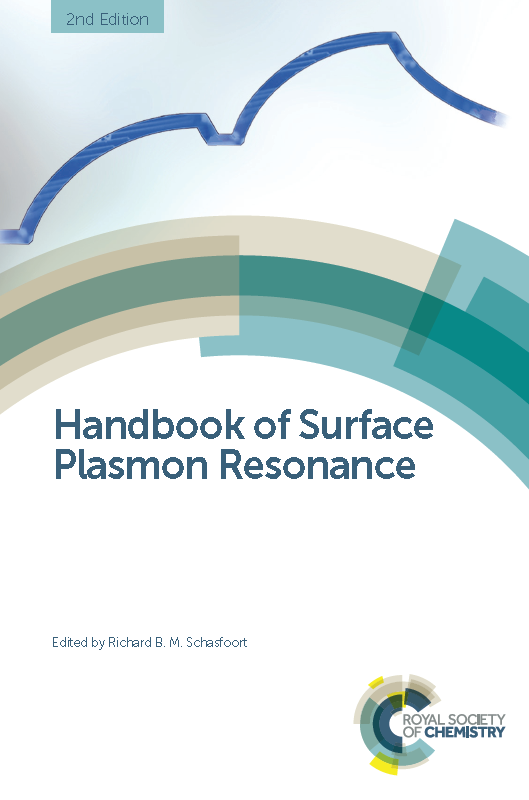SPR books - general
Below some books I found interesting to read and used to make this site.
 |
Surface Plasmon Resonance (SPR): advances in Research and Applications
Douglas Howell (Editor) Nova Science Publishers 2017, 140 pages softcover ISBN: 978-1-53611-857-5 Chapter 1. Possible Applications of the SPR Devices for Medical and Microbiological Investigations Chapter 2. Surface Plasmon-Induced Variation in the Properties of Gold Nanoparticle-Doped Nematic Liquid Crystals Chapter 3. Localized Surface Plasmon Resonance-Active Surfaces Applied to Study Interactions of Biomolecules |
 |
Handbook of Surface Plasmon Resonance 2nd edition
Richard B M Schasfoort (Editor) RSC 2017, ca. 500 p., hardcover ISBN 978-1-78262-730-2 Surface plasmon resonance (SPR) plays a dominant role in real-time interaction sensing of biomolecular binding events. This book focuses on a total system description including optics, fluidics and sensor surfaces. It covers all commercial SPR systems in the market. It is the first of its kind and fills a gap in the technical literature as no other handbook on SPR is currently available. The 2nd edition is a total revised and updated handbook and with a chapter written by the sprpages. The final chapter discussed new trends and a vision is given for future developments and needs of the SPR market. This excellent handbook provides comprehensive information with easy to use, stand-alone chapters and will be of great use to anyone one working with or affiliated to the technology. |
 |
Surface Plasmon Resonance
Series: Nanotechnology Science and Technology Pranveer Singh 2014, 122 p., softcover and e-book ISBN: 978-1-63321-835-2 The success of SPR biosensors was indicated by the growing number of commercially available instruments. Since Biacore AB (originally Pharmacia Biosensor AB) launched the first commercial SPR biosensor on market in 1990, there have been many more competing SPR instruments including IASys (Affinity Sensors), SPR-670 (Nippon Laser Electronics), IBIS (IBIS Technology BV), TISPR (Texas Instruments), etc. Plasmon resonance techniques such as SPR, SPR-imaging, SPR-MS (mass spectrometry) and PWR, trends in protein array technology and a potential use of SPR biosensors in proteome and optics based research will be reviewed in terms of their fundamentals, and in the latest applications with emphasis in studies performed with membrane proteins. |
 |
Handbook of Surface Plasmon Resonance 1st edition
Richard B M Schasfoort (Editor) RSC 2008, ca. 425 p., hardcover ISBN-10: 0854042679 Surface plasmon resonance (SPR) plays a dominant role in real-time interaction sensing of biomolecular binding events. Although the last decades have seen the birth of various books on sensors and biosensors with some mention of surface plasmon resonance, such a comprehensive work on SPR covering the issues relevant for the interested student or the practicing researcher has long been awaited. The Handbook of Surface Plasmon Resonance covers all relevant aspects of present technology spanning a bridge between theory, instrumentation and applications. The book provides a thorough theoretical introduction, including kinetic models of biomolecular interactions as well as a practical guide for assay development. The book describes the instrumentation of SPR in terms of optics, fluidics, surface chemistries and kinetics with an easy-to-follow guide of how to use the technique providing relevant applications. The history of SPR, new trends, and a vision of future developments and needs of the SPR market are given. The potential of SPR is revealed by showing highly exciting and unique opportunities for unraveling the functional relationships of complex biological processes. The book is a comprehensive source of information with easy to use, stand-alone chapters, and will be essential for scientists in industry and academia working with or affiliated to the technology. Intended for a wide audience, The Handbook of Surface Plasmon Resonance is also students aspiring to use the technology, and the wide public interested in SPR as a phenomenon and in its applications. |
 |
Real-Time Analysis of Biomolecular interactions - Applications of Biacore
Nagata, K. & Handa, H. Springer-Verlag 2000, 256 p., hardcover ISBN 40431-70289-X General introduction to surface plasmon resonance and the Biacore system and some basics of the experimental procedure. Greater part consist of the applications with SPR and Biacore. Applications are explaned by real experiments and data analysis and contain a reference list. |
 |
Surface Plasmon Resonance Based Sensors
Series: Springer Series on Chemical Sensors and Biosensors, Vol. 4 Homola, Jirí (Ed.) Springer 2006, XII, 251 p., hardcover ISBN 978-3-540-33918-2 Also available online The book is divided into three parts. Part I introduces readers to the fundamental principles of surface plasmon resonance (bio)sensors and covers the electromagnetic theory of surface plasmons, the theory of SPR sensors and molecular interactions at sensor surfaces. Part II presents a review of the state of the art in the development of SPR sensor instrumentation and functionalization methods. Part III discusses applications of SPR biosensors for study of molecules and their interactions and detection of chemical and biological analytes related to environmental monitoring, food safety and security and medical diagnostics. |
 |
Surface Plasmon Resonance Methods and protocols.
Series: Methods is Molecular Biology, vol. 627 Mol, N.J.; Fischer, M.J.E. (Eds.) Springer 2010, X, 255p, 77 illustrations., 6 in color. ISBN 978-1-60761-669-6 Provides detailed protocols for a wide variety of SPR applications. Includes comprehensive background information on SPR techniques for better experimental design. Examines a variety of coupling techniques on different sensor surfaces. Highlights background issues involved in SPR assays to avoid common errors frequently found in SPR literature. Presents protocols in clear step by step procedures including the basics of kinetic analysis. Focuses on a wide range of applications for membrane-bound protein interactions, including G protein-coupled receptors. Chapters on the combination of SPR with mass spectrometry (SPR-MS) for quantification and identification of proteins. Written for users of commercially available SPR equipment. Covers the two most common sources of deviation from ideal kinetics: mass transport and surface heterogeneity. |
 |
Plasmonics: Fundamentals and Applications
Stefan A. Maier Springer; 1 edition (May 15 2007), 223p. Englisch, hardcover ISBN-10: 0387331506 ISBN-13: 978-0387331508 |